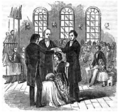Portal:Latter Day Saint movement
|
Welcome to the portal of The Latter Day Saint movement
Introduction The Latter Day Saint movement (also called the LDS movement, LDS restorationist movement, or Smith–Rigdon movement) is the collection of independent church groups that trace their origins to a Christian Restorationist movement founded by Joseph Smith in the late 1820s. Collectively, these churches have over 17 million nominal members, including over 17 million belonging to the Church of Jesus Christ of Latter-day Saints (LDS Church), 250,000 in the Community of Christ, and several other denominations with memberships generally ranging in the thousands of members. The predominant theology of the churches in the movement is Mormonism, which sees itself as restoring again on Earth the early Christian church; an additional doctrine of the church allows for prophets to receive and publish modern-day revelations. A minority of Latter Day Saint adherents, such as members of Community of Christ, have been influenced by Protestant theologies while maintaining certain distinctive beliefs and practices including continuing revelation, an open canon of scripture and building temples. Other groups include the Remnant Church of Jesus Christ of Latter Day Saints, which supports lineal succession of leadership from Smith's descendants, and the more controversial Fundamentalist Church of Jesus Christ of Latter-Day Saints, which defends the practice of polygamy. (Full article...) General images -The following are images from various Latter Day Saint movement-related articles on Wikipedia.
Selected article Blood atonement was a doctrine in the history of Mormonism still adhered to by some fundamentalist splinter groups, under which the atonement of Jesus does not redeem an eternal sin. To atone for an eternal sin, the sinner should be killed in a way that allows his blood to be shed upon the ground as a sacrificial offering, so he does not become a son of perdition. The largest Mormon denomination, the Church of Jesus Christ of Latter-day Saints (LDS Church), has denied the validity of the doctrine since 1889 with early church leaders referring to it as a "fiction" in spite of evidence to the contrary and later church leaders referring to it as a "theoretical principle" that had never been implemented in the LDS Church. The doctrine arose among early Mormon leaders and it was significantly promoted during the Mormon Reformation, when Brigham Young governed the Utah Territory as a near-theocracy. According to Young and other members of his First Presidency, eternal sins that needed blood atonements included apostasy, theft and fornication (sodomy and adultery were two sins that did not need blood atonements). (Full article...)Selected location
Voree (/vɔːriː/) is an unincorporated community in the Town of Spring Prairie in Walworth County, Wisconsin, United States. It is best known as the headquarters of the Church of Jesus Christ of Latter Day Saints (Strangite), a denomination of the Latter Day Saint movement. According to James Strang, founder of the Strangite church and of the town, the name means "Garden of Peace". The community is situated along former Wisconsin Highway 11, just west of the Racine County line. (Full article...)
Selected schismatic histories
The Church of Christ, informally called Hedrickites and the Church of Christ (Temple Lot), is a denomination of the Latter Day Saint movement headquartered in Independence, Missouri, on what is known as the Temple Lot. The nickname for members of the church comes from the surname of Granville Hedrick, who was ordained as the church's leader in July 1863. Unlike the Church of Jesus Christ of Latter-day Saints (LDS Church) and Community of Christ, the Temple Lot church rejects the office of prophet or president, being instead led by its Quorum of Twelve Apostles. The church also rejects the doctrines of baptism for the dead and celestial marriage promulgated by the Utah-based LDS Church, as well as the Doctrine and Covenants and Pearl of Great Price. While once avidly engaged in dialogue with other Latter Day Saint factions, the church no longer has any official contact with any other organization. It is notable for its sole ownership of the Temple Lot, which it has held for nearly 150 years. As of 2013, membership is 7,310 members in 11 countries. Most of the members live in the United States, but there are parishes in Canada, Mexico, Honduras, Nigeria, Kenya, Democratic Republic of the Congo, Malawi, Tanzania, India, Ethiopia, and the Philippines. (Full article...)
OutlinesRelated portalsKey biographies
Selected image The Red Brick Store in Nauvoo, Illinois. Constructed and owned by Joseph Smith, Jr., it became a center of economic, political, religious, and social activity among the Latter Day Saints.
Did you know (auto generated)
Selected Anniversaries
Selected quote
TopicsFeatured contentCategoriesWikiProjectsAssociated WikimediaThe following Wikimedia Foundation sister projects provide more on this subject:
Discover Wikipedia using portals | ||||||||||







































